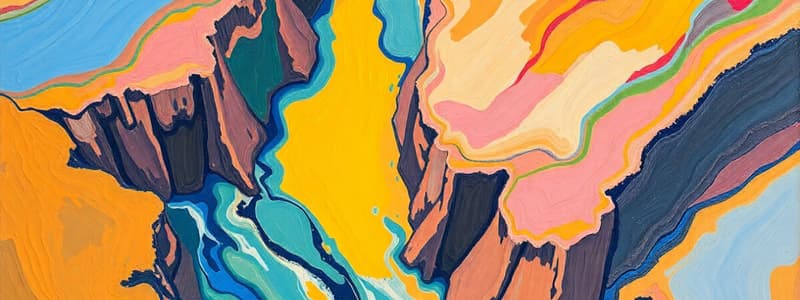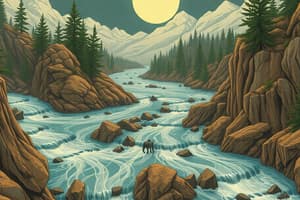Podcast
Questions and Answers
Approximately what percentage of a river's energy is typically used to overcome friction?
Approximately what percentage of a river's energy is typically used to overcome friction?
- 5%
- 95%
- 50%
- 25% (correct)
The amount of energy in a river is solely determined by the volume of water it contains.
The amount of energy in a river is solely determined by the volume of water it contains.
False (B)
Name the three sections that can typically be recognized along a river's course.
Name the three sections that can typically be recognized along a river's course.
upper, middle, and lower course
The combination of a river's sections forms the long ______ of the river.
The combination of a river's sections forms the long ______ of the river.
Match the river characteristic with its behavior from the source to the mouth of the river.
Match the river characteristic with its behavior from the source to the mouth of the river.
What is the definition of 'discharge' in the context of a river?
What is the definition of 'discharge' in the context of a river?
Erosion is only caused by water; other natural elements do not contribute.
Erosion is only caused by water; other natural elements do not contribute.
Name two of the four key processes of erosion.
Name two of the four key processes of erosion.
River erosion caused when the sheer force of river water removes loose material is called ______.
River erosion caused when the sheer force of river water removes loose material is called ______.
Which type of erosion is characterized as the 'wearing away' of the river bed and banks caused by the river's load?
Which type of erosion is characterized as the 'wearing away' of the river bed and banks caused by the river's load?
Attrition results in sharp-edged rocks becoming jagged and larger over time.
Attrition results in sharp-edged rocks becoming jagged and larger over time.
What type of rock erodes through solution?
What type of rock erodes through solution?
________ erosion causes the valley to grow very slowly upstream.
________ erosion causes the valley to grow very slowly upstream.
When is erosion most likely to occur in rivers?
When is erosion most likely to occur in rivers?
Vertical erosion primarily widens a valley.
Vertical erosion primarily widens a valley.
Which type of erosion widens the valley in middle and lower courses?
Which type of erosion widens the valley in middle and lower courses?
Match the type of erosion with its location along a river.
Match the type of erosion with its location along a river.
What does the term 'load' refer to in the context of river transportation?
What does the term 'load' refer to in the context of river transportation?
In traction, small particles bounce along the bed in a leap-frog motion.
In traction, small particles bounce along the bed in a leap-frog motion.
Name the four processes by which a river transports its load.
Name the four processes by which a river transports its load.
The process of river transportation where silt and clay-sized sized particles are carried within the water flow is known as ______.
The process of river transportation where silt and clay-sized sized particles are carried within the water flow is known as ______.
Which of the transportation processes requires the least amount of energy?
Which of the transportation processes requires the least amount of energy?
River friction refers to the force that helps speed up the water's velocity.
River friction refers to the force that helps speed up the water's velocity.
What causes the slowing down of the water's velocity due to river friction?
What causes the slowing down of the water's velocity due to river friction?
The force of the water flow pushes air into the cracks in the river bank. Air within the cracks is compressed under great pressure, breaking up parts of the river bank. This is called ______.
The force of the water flow pushes air into the cracks in the river bank. Air within the cracks is compressed under great pressure, breaking up parts of the river bank. This is called ______.
At the upper course of a river, the gradient is steep and the river flows quickly, resulting in what?
At the upper course of a river, the gradient is steep and the river flows quickly, resulting in what?
LAT in lateral erosion, is used to remember 'lat is thin'.
LAT in lateral erosion, is used to remember 'lat is thin'.
What type of erosion is like a hairline?
What type of erosion is like a hairline?
For transportation, rolling stones along the bed needs most ______.
For transportation, rolling stones along the bed needs most ______.
Match type of transportation with its description
Match type of transportation with its description
Flashcards
River friction
River friction
Resistance when flowing water contacts the riverbed/banks, slowing the water's velocity.
River energy determinants
River energy determinants
The amount of water in the river and the speed at which the river is flowing.
River sections
River sections
Upper, middle, and lower course.
Volume (river)
Volume (river)
Signup and view all the flashcards
Velocity (river)
Velocity (river)
Signup and view all the flashcards
Discharge (river)
Discharge (river)
Signup and view all the flashcards
Hydraulic action
Hydraulic action
Signup and view all the flashcards
Corrasion (abrasion)
Corrasion (abrasion)
Signup and view all the flashcards
Attrition (river)
Attrition (river)
Signup and view all the flashcards
Solution (river erosion)
Solution (river erosion)
Signup and view all the flashcards
Vertical erosion
Vertical erosion
Signup and view all the flashcards
Lateral erosion
Lateral erosion
Signup and view all the flashcards
Headward erosion
Headward erosion
Signup and view all the flashcards
River load
River load
Signup and view all the flashcards
Traction (river transport)
Traction (river transport)
Signup and view all the flashcards
Saltation (river transport)
Saltation (river transport)
Signup and view all the flashcards
Suspension (river transport)
Suspension (river transport)
Signup and view all the flashcards
Solution (river transport)
Solution (river transport)
Signup and view all the flashcards
Study Notes
- Rivers are dynamic systems shaped by energy and various processes.
Energy and Friction
- About 95% of a river's energy overcomes friction.
- River friction refers to the resistance encountered by flowing water as it interacts with the riverbed and banks, slowing down water velocity.
- The remaining 5% of a river's energy erodes the river channel and transports material downstream.
- A river’s energy depends on the amount and speed of the water flow within.
River Sections and Profiles
- Rivers are divided into three sections: the upper, middle, and lower course.
- These sections form the long profile of the river.
- From source to mouth, the river's gradient decreases, while its depth, velocity, width, volume, and discharge increase.
- Volume refers to the amount of water.
- Velocity refers to the speed of the water.
- Discharge is the product of volume and velocity, representing the amount of water passing a specific point at a given time.
Erosion Processes
- In most countries, rivers are major causes of both erosion and deposition.
- There are four main erosion processes:
- Hydraulic action: the sheer force removes loose material from the riverbed and banks, most effective on banks, and can lead to undercutting and collapse.
- Corrasion (abrasion): the wearing away of the bed and banks by the river's load and particle size varies.
- Attrition: pieces of rock break away and collide with each other, smoothing edges and reducing size over time.
- Solution: rocks like limestone dissolve slowly in river water containing dissolved carbon dioxide.
Erosion on the Landscape
- Most erosion peaks when discharge is high and rivers flood.
- Erosion affects the landscape in three ways:
- Vertical erosion: near the source a river cuts into its bed, deepening the valley, forming V-shaped valleys.
- Lateral erosion: in middle and lower courses, widens the valley.
- Headward erosion: this occurs at the source.
Transportation
- Load refers to the total material load carried by a river.
- Rivers transport loads through four processes:
- Traction is the rolling of stones along the riverbed, requiring the most energy.
- Saltation happens when sand-sized particles bounce along the riverbed.
- Suspension where silt- and clay-sized particles are carried within the water flow.
- Solution-some minerals dissolve in water and takes the least energy.
Studying That Suits You
Use AI to generate personalized quizzes and flashcards to suit your learning preferences.



